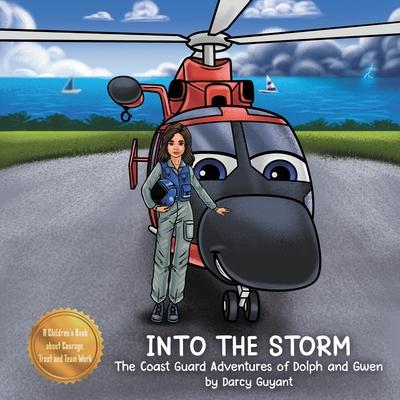A severe storm quickly develops catching three fishermen on off guard in the open ocean. They are in danger of sinking and need help, fast! Who will come to their rescue? Dolph, a Coast Guard HH-65 "Dolphin" rescue helicopter and his pilot, Gwen, quickly respond to save the three men in distress. But the mission is not easy. Courage, team work, and trusting the team to do their jobs are essential.
In order to get to the sinking boat as quickly as possible, they must fly directly into the storm to reach the men in time. Flying into the strong storm makes Dolph and Gwen very nervous. They must trust each other, work as a team, and show courage to save the men who are in danger of drowning.
Dolph, Gwen, the Rescue Swimmer (Sam), and the Flight Mech (Mike) work together to accomplish the mission, even while facing additional unexpected challenges.
This empowering story not only celebrates the bravery of Coast Guard heroes but also highlights the vital role of women in aviation. Gwen, a talented pilot, leads the charge to with confidence and expertise, showing young readers that women can excel in high-stakes, action-packed environments. Gwen symbolizes what it means to "fly like a girl."
Illustrated with vibrant imagery that captures the thrill of flying, this story is a captivating read for children of all ages, especially those interested in airplanes, helicopters, how things work, the jobs they perform, and the people who fly them.
The author, Mr. Darcy Guyant, is a retired U. S. Coast Guard HH65 Dolphin helicopter pilot. This story is an exciting true story based on a real-life rescue mission flown by Mr. Darcy and his crew in a Coast Guard Helicopter just like Dolph, but without eyes and a mouth, of course.
This book also serves as a excellent introduction to STEM (science, technology, engineering and mathematics) lessons and discussions on the differences between airplanes and helicopters and how they fly.
Lift Mechanism
Airplanes relies on wings to generate lift by air flowing over the wings.
Helicopters generate lift by rotating it's wings (rotor blades) very fast through the air.
Forward Motion
Airplanes are propelled forward by jets or propellers
Helicopters can hover in place and move in any direction. Forward motion is achieved by tilting the rotor blades forward.
Control Surfaces
Airplanes employs control surfaces such as ailerons, elevators, and rudders to control roll, pitch, and yaw respectively.
Helicopters utilizes cyclic, collective, and tail rotor controls.
Speed and Altitude
Airplanes are typically capable of higher speeds and altitudes due to its aerodynamic design and propulsion system.
Helicopters generally, operates at lower speeds and altitudes but offers versatility in maneuverability and the ability to land and take off vertically.
Runway Requirement
Airplanes requires a runway for takeoff and landing due to its forward motion for lift.
Helicopters can take off and land vertically, eliminating the need for a runway. It can operate in confined spaces and land in remote areas.
Stability
Airplanes are generally more stable in flight, especially at high speeds, due to inherent aerodynamic stability.
Helicopters requires constant pilot input to maintain stability, particularly during hover and low-speed flight.
"If a man is in need of rescue, an airplane can come in and throw flowers on him, and that's just about all. But a could come in and save his life." Igor Sikorsky
